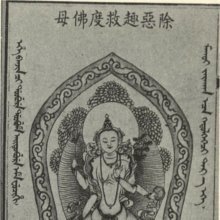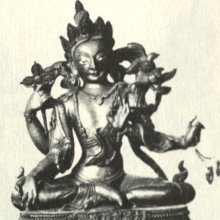Durgottarinitara, Durgottāriṇītārā, Durgottarini-tara: 1 definition
Introduction:
Durgottarinitara means something in Buddhism, Pali. If you want to know the exact meaning, history, etymology or English translation of this term then check out the descriptions on this page. Add your comment or reference to a book if you want to contribute to this summary article.
Images (photo gallery)
In Buddhism
Tibetan Buddhism (Vajrayana or tantric Buddhism)
Source: archive.org: The Indian Buddhist IconographyDurgottarinitara (दुर्गोत्तरिनितर) or Durgottāriṇī refers to a deity from the Green Tārā family, according to Buddhist Iconography.—Durgottāriṇītārā has green complexion, the lotus for her seat, and garments of white colour; she has four arms and she carries m the first pair of hands the noose and the goad and displays in the second the lotus and the Varadamudrā. [...] Strictly speaking, only those deities can be called Tārās to whom the mantra: “oṃ tārā tuttāre ture svāhā” is assigned. [...] From the colour of the different Tārās it will be possible to refer them [viz., Durgottāriṇītārā] to their respective Kulas or families presided over by the five Dhyāni Buddhas.

Tibetan Buddhism includes schools such as Nyingma, Kadampa, Kagyu and Gelug. Their primary canon of literature is divided in two broad categories: The Kangyur, which consists of Buddha’s words, and the Tengyur, which includes commentaries from various sources. Esotericism and tantra techniques (vajrayāna) are collected indepently.
See also (Relevant definitions)
Partial matches: Durgottarini, Tara.
Full-text: Durgottarini.
Relevant text
No search results for Durgottarinitara, Durgottāriṇītārā, Durgottarini-tara, Durgottāriṇī-tārā; (plurals include: Durgottarinitaras, Durgottāriṇītārās, taras, tārās) in any book or story.
Related products

